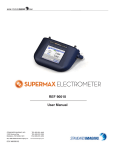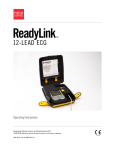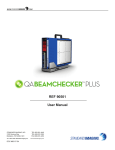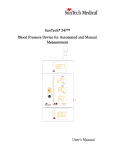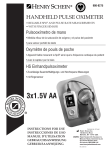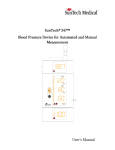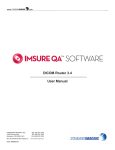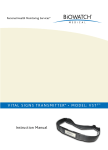Download REF 90015 See MAX COMM™ Software package for installation CD
Transcript
WWW. .COM REF 90015 See MAX COMM™ Software package for installation CD-ROM STANDARD IMAGING, INC. 3120 Deming Way Middleton, WI 53562-1461 TEL 800.261.4446 TEL 608.831.0025 FAX 608.831.2202 Jun / 2011 ©2011 Standard Imaging, Inc. DOC #80206-22 General Precautions WARNING: Proper use of this device depends on careful reading of all instructions and labels. WARNING: An electrical shock hazard of up to 450 VDC is possible whenever the bias voltage is active. Always set the bias to 0 VDC whenever a device is connected to or disconnected from the MAX 4000. WARNING: Electric shock hazard. Refer servicing to a qualified individual. WARNING: The MAX 4000 is not intended to be used in flammable mixture atmospheres. Do not use with flammable anesthetic mixture with air, with oxygen, or nitrous oxide. WARNING: Where applicable, Standard Imaging products are designed to be used with the versions of common radiation delivery devices, treatment planning systems and other products or systems used in the delivery of ionizing radiation, available at the time the Standard Imaging product is released. Standard Imaging does not assume responsibility, liability and/or warrant against, problems with the use, reliability, safety or effectiveness that arise due to the evolution, updates or changes to these products or systems in the future. It is the responsibility of the customer or user to determine if the Standard Imaging product can be properly used with these products or systems. CAUTION: Input voltage on triax connector should be no greater than +5 V or -5 V. CAUTION: Only connect the RS-232 serial port to equipment where no risk of external voltage exists. CAUTION: This device should never be submerged in water or a solvent to clean, or scrubbed with an abrasive cleaner. Do not drop or mishandle unit. Calibration factor changes may result. Warnings and Cautions alert users to dangerous conditions that can occur if instructions in the manual are not obeyed. Warnings are conditions that can cause injury to the operator, while Cautions can cause damage to the equipment. CAUTION: Damaged or kinked ionization chamber cables or extension cables should not be used. CAUTION: Upon power on, allow for proper warm up. CAUTION: Charge measurements made in modes other than those used by the calibration agency may result in measurement errors which exceed the calibration uncertainty. CAUTION: When connecting or disconnecting an ionization chamber to the MAX 4000, set the bias voltage to 0 VDC. CAUTION This revision of the user manual refers only to MAX 4000 units with a serial number starting with the letter F. MAX 4000 units with a serial number starting with the letter E should refer to user manuals with a revision number lower than 19 (See cover: 80206-19). CAUTION: For best performance, select the lowest range possible for the intended measurement. CAUTION: Use provided power supply or equivalent as identified by Standard Imaging. Contact Standard Imaging for additional information. CAUTION: To ensure long-term performance of the internal battery, it is recommended to fully recharge the Max 4000 Electrometer monthly. CAUTION: Do not disassemble unit since it may result in change of calibration factor. Refer servicing to qualified individuals. 2 Table of Contents PAGE 2 General Precautions 3 General Operation 5 Front Panel 5 Rear Panel 6 Setting up the MAX 4000 8 Using the MAX 4000 10 MAX COMM™ Software 10 Maintenance 11 Description of Symbols 11 Parts and Accessories List 12 Troubleshooting 14 Features and Specifications 19 Service Policy 19 Customer Responsibility 20 Warranty 3120 DEMING WAY MIDDLETON, WI 53562-1461 USA WWW.STANDARDIMAGING.COM General Operation 1. Unless operating on battery power, connect the detachable AC power cord to the provided Globtek®, Inc. power supply, attach the AC power cord to a grounded 120 VAC or 220/240 VAC 50/60 Hz power outlet, and connect the power supply to the MAX 4000 Electrometer power adapter input. 5. Connect the ionization chamber to the MAX 4000 and select the desired voltage bias. Allow at least 10 minutes for the system to stabilize. 2. With nothing connected to the input connector of the MAX 4000, turn the power on and wait at least 10 minutes for the electrometer to warm up. 7. Press and hold the MODE/ZERO button and repeat the zeroing process in Step 3, but with the ionization chamber connected. This is the system zero adjustment. 8. Check the system leakage. Take a reading without exposing the chamber to radiation. This reading should be less than 0.1% of the final signal expected. 3. Select the desired Range of Operation, Low or High, with the arrow buttons, followed by the MODE/ZERO button. NOTE: For best performance, select the lowest range possible for the intended measurement. 4. Press the Start button to perform the electrometer zero adjustment. This will take about one minute. 6. Verify the leakage of the ionization chamber is within the manufacturer’s stated acceptable limits. 9. Measure the atmospheric temperature and pressure. 3 General Operation Continued 10. Turn on or insert the radiation source(s) and take at least 3 measurements. Further explanation of the Range, Trigger, Rate, Charge, and Rate/Charge modes can be found on pages 5-8. 11. Analyze the data taking into account the average of the readings, system leakage, temperature/pressure corrections, calibration factors and any other appropriate corrections to be made. 12. When all measurements are completed, set bias voltage to 0 VDC, turn off the MAX 4000 and disconnect the ionization chamber. 13. If using the power supply and if desired, disconnect the power supply from the MAX 4000 and disconnect the detachable AC power cord from the power supply. 4 Front Panel Rear Panel 1 2 7 3 4 5 6 1 Power/Standby LED: When lit, the MAX 4000 is powered on. 2 Power button: Turns the unit on/off. 3 4 1 Battery Charging LED: When lit, the battery charger is energized and charging the internal battery. External reset switch: In the unlikely event that the device stops responding, use a small diameter rod to lightly press the internal button and reset the device. 2 Input connection: A standard two lug, BNC, triax connector for signal input. This connector features low leakage current properties. The signal current is carried on the central lead, the guard carries the high voltage and the outermost ring is ground. RS-232 serial port: A standard 9-pin serial port for remote observation or data recording. This port is for connection to equipment where no risk of external voltage exists. 3 2.1 mm Battery Charger Input: Connect the battery charger to this input jack when charging the internal battery. Note: If the MAX 4000 is being used in a patient environment, do not plug in the charger. Connect to mains power through an isolation transformer only. 0-450 VDC / 350 µA max To protect the input connector, always replace the chain cap when the MAX 4000 is not in use. 5 MODE/ZERO button: Press to toggle through the modes in the following order: Range, Bias, Threshold Levels, Rate, Charge and Rate/Charge. Press and hold for 2 seconds to select the zero adjustment procedure and perform system zero. 7 2 1 . 6 3 START/RESET button: Press to start and stop timed charge collections in the Charge or Rate/Charge mode, or to reset the display following a collection. Arrow buttons: Press to toggle the Range selection, voltages in the Bias Mode, or to select the time period increments for taking a charge reading. 5 Setting up the MAX 4000 Before using the MAX 4000 to take measurements, perform the following steps to ensure accurate readings. The MAX 4000 features an automatic zero function and a convenient way to check battery status and bias level. Auto Warm Up and Zero Adjustment 1. Turn on the MAX 4000. The display will count down a 10:00 minute warm up. The warm up may be bypassed by pressing the MODE/ZERO button. If you choose to bypass the warm up, be aware that repeatability and leakage specifications may not be achieved until 10 minutes has elapsed. 2. 3. Select the desired Range of Operation, Low or High, with the arrow buttons, followed by the MODE/ZERO button. Press the Start button to perform the zero adjustment. This process will take 60 seconds. 3. Bias Mode 1. The charge level of the internal battery is displayed in percent. When the battery capacity drops below 15%, the display will read “RECHARGE BATTERY.” 2. -300 VDC -150 VDC 0 VDC 150 VDC NOTE: Each Range of Operation must be zeroed upon initial use. To perform subsequent zero adjustments, press and hold the MODE/ZERO button for two seconds. 1. The measuring range of the MAX 4000 is displayed as High or Low. The actual numeric range is also shown to indicate the proper units of measurement for each range. NOTE: For best performance, select the lowest range possible for the intended measurement. 2. Use the arrow buttons to select the bias level from the following options: -450 VDC The display will read “ZEROING COMPLETE.” The MAX 4000 now defaults to the Bias Mode. Range Selection Mode Use the MODE/ZERO button to select mode of operation. You may use the MODE/ZERO button to return to the range selection mode at any time. 300 VDC 450 VDC 3. Press the MODE/ZERO button to select a mode of operation. You may return to the Bias Mode at any time to change the bias voltage. CAUTION: When connecting or disconnecting an ionization chamber to the MAX 4000, set the bias voltage to 0 VDC. Use the arrow buttons to select the desired range of operation. Range change is immediate. 6 Setting up the MAX 4000 Continued Trigger Mode Threshold Levels System Zeroing The MAX 4000 Electrometer has a trigger mode, which allows it to automatically detect the start and stop of a radiation exposure by measuring the current crossing predetermined limit thresholds. The start and stop thresholds are set independently, with the default settings of start 0.8 pA and stop 0.5 pA. Threshold limits cannot be set to 0.0. When making measurements in the presence of larger leakage currents, it may be necessary to raise the threshold limits. Conversely, since the start threshold determines the minimum dose rate, it may be necessary to lower the thresholds for other measurements. 1. Connect the ionization chamber to the MAX 4000 and select the desired voltage bias. Allow at least 10 minutes for the system to stabilize. 2. Verify the leakage of the ionization chamber is within the manufacturer’s stated acceptable limits. 3. Press and hold the MODE/ZERO button for 2 seconds to repeat the zeroing process, but with the ionization chamber connected. This is the system zero adjustment. 1. The threshold start and stop levels are displayed in pA and are adjustable from 0.01 - 9.99 pA. 2. Use the START/RESET button to select the digit to adjust. 3. Use the arrow buttons to adjust the selected digit from 0 to 9. 4. Both values must be larger than zero, and the start value must be larger than the stop value. 5. Use the MODE/ZERO button to select mode of operation. You may use the MODE/ZERO button to return to the Threshold Levels mode at any time. 6. If invalid numbers are entered, the invalid entry will be displayed after pressing the MODE/ZERO button. 7 Using the MAX 4000 Charging the internal battery 1. When the battery capacity is 15% or less, “RECHARGE BATTERY” appears on the display. Plug the 2.1 mm plug of the charger into the electrometer and the other end into mains power. 2. Whenever external power is supplied, the small amber light adjacent to the MODE/ZERO button on the front panel is lit. This activates the charging circuit and the Battery percent display in the Bias Mode will indicate “CHRG”. 3. The MAX 4000 will also operate with the charger plugged into a wall outlet, regardless of the battery capacity. Re-charging the battery takes 6 - 8 hours. The MAX 4000 may be continually charged with no detrimental effects to the internal battery. 4. To ensure long-term performance of the internal battery, it is recommended to fully recharge the MAX 4000 Electrometer monthly. NOTE: Depending on the type of measurements performed, leakage currents within the ionization chamber can be a significant portion of the measured data. The electrometer zero can be adjusted to compensate for leakage currents of the ionization chamber by pressing and holding the MODE/ZERO button for 2 seconds after the chamber has been connected and the system has warmed up. This will place the electrometer into the zeroing mode and a system zero can begin. This is applicable for the both the Rate and Charge modes. Refer to page 6 for more information on system zeroing. 1. Use the Range mode to select the range of operation. 2. Use the Bias Mode to set the bias voltage. 3. Use the MODE/ZERO button to select the Rate Mode. 4. Irradiate the ion chamber with a radioactive source. 5. The MAX 4000 will begin to measure the current. For signals 2 nA and below, allow about 12 seconds for the signal to stabilize. For signals above 2 nA, wait about 3 seconds for stabilization. 6. The Rate measurement will be displayed. Automatic shutdown To maximize battery life, the MAX 4000 will shut off automatically if it is not plugged into the wall charger and is left unattended for more than 3 hours. Rate Mode NOTE: Rate measurements over 500.00 nA (High range) or 1000.0 pA (Low range) will produce an “OVERLOAD” message. 8 Using the MAX 4000 Continued Charge Mode & Rate/Charge Mode 1. Use the Range mode to select the range of operation. 2. Use the Bias Mode to set the bias voltage. 3. Use the MODE/ZERO button to select the Charge Mode or Rate/Charge Mode. Select a Charge Collection Mode (Proceed to desired step 4) 4. Timed Mode Use the arrow buttons to select the collection time. Time periods from 0 - 600 seconds are available in 15 second increments. 5. Irradiate the ionization chamber. 6. Press the START/RESET button. The MAX 4000 will count down from the time set and display the charge accumulated. When the countdown is complete, the charge accumulated will remain until the unit is reset. 7. 8. Record the reading and press the START/RESET button to clear the reading and reset to the chosen collection time. Repeat steps 4 - 7 for other charge readings. NOTE: Charge measurements greater than 999,999 nC will produce an “OVERLOAD” message. Continuous Mode Trigger Mode 4. Use arrow buttons to select CON. 4. Use arrow buttons to select TRG DET. 5. Press START/RESET button to start charge collection. The MAX 4000 will continue to collect charge until stopped by pressing the START/RESET button. 5. Press START/RESET button to start detection. Meter will display TRG RDY. 6. Irradiate the ionization chamber. 7. Record the reading after irradiation period. 8. Press START/RESET to stop collection and reset reading. 6. Irradiate the ionization chamber. 7. When the threshold start level is exceeded, the MAX 4000 will begin to collecting charge and the display will change to TRG TRG. 8. The MAX 4000 will continue to collect charge until the measured current is below the threshold stop level. When stopped, the display will change to TRG RDY. 9. Record charge value. 9. Repeat steps 4-8 for other charge readings. NOTE: The charge collection is erased when stopped, so record value before stopping electrometer. 10. Repeat steps 6-10 for other charge readings. 11. Press START/RESET button to exit threshold charge collections. The display will change to TRG DET. 9 MAX COMM™ Software The MAX 4000 electrometer is compatible with Standard Imaging MAX COMM software. MAX COMM expands the functionality of a MAX series electrometer by adding chamber libraries, temperature/pressure correction factors, and more. The program installation package is included with your MAX 4000 shipment, with an enclosed CD-ROM. The MAX COMM user manual is available electronically in PDF format on the program CD-ROM and includes detailed instructions for installation, setup, and use with this electrometer. Maintenance As is standard practice for other electrometers, it is recommended that the MAX 4000 be calibrated every 2 years. This calibration should be performed by an Accredited Dosimetry Calibration Laboratory. Exterior cleaning of the device can be done with a soft brush and a cloth. Gently brush all surfaces to remove dirt and dust. Remove any remaining dirt with a cloth slightly dampened with a solution of mild detergent and water or a liquid disinfecting agent. Do not use water or liquid on triax jack. Do not permit any liquid to seep into the MAX 4000 in any manner during cleaning, as there is no protection from the harmful ingress of water. It is not recommended to clean the window of the LCD with anything other than a mild detergent and a very soft cloth. Failure to use a soft cloth may result in a scratched window, and this may impair the visibility of the LCD. No sterilization of the MAX 4000 is required. Qualified individuals may replace the Lead Acid battery. An illustrated instruction booklet is available and is distributed with the replacement battery from Standard Imaging. See the Parts and Accessories List below. There are no other user serviceable parts in the MAX 4000. If assistance is desired in the proper disposal of this product (including accessories and components), after its useful life, please return to Standard Imaging. 10 Description of Symbols The following symbols are found on the MAX 4000: Power On/Off Switch Dangerous Voltage Present Inside Enclosure Attention, Consult Accompanying Documents Signal Input Battery Charge Level Reset Power On Parts and Accessories List REF Description 90015 80206 72731 20194 20193 72730 73006 75501 4426 MAX 4000 Electrometer MAX 4000 User Manual MAX 4000 Power Supply/Battery Charger 25 ft. Serial Cable 100 ft. Serial Cable Optional International Power Cord Set Lead Acid Battery Replacement Kit, including power supply MAX COMM Software Technical Note-Command Set for Bi-directional RS-232 operation 11 Troubleshooting Questionable Readings If readings are off, determine if there is any leakage from the MAX 4000 or ionization chamber. Follow steps 1 - 8 under General Operation. If going through the General Operation instructions does not resolve leakage issues, a dirty connector could be the cause. Over the years, Standard Imaging has had product reports of drift or leakage involving its ion chambers, well chambers and electrometers. During the investigation and/or servicing of these products it became apparent a significant portion of these reports were caused by dirty triax connectors. The cause is typically dust that has collected on the inside connector. To minimize these reports and unnecessary service, Standard Imaging is providing a triax connector cleaning procedure. This triax connector cleaning procedure should be periodically completed or whenever there are concerns of drift or leakage. Heavier product use may require more frequent cleanings. Prior to cleaning a triax connector, ensure: • The ion chamber or well chamber is disconnected from the electrometer. • There is no water or moisture visible in the triax connector. To clean a dirty triax connector: • Remove the connector cap (if applicable). • Use only a dry and oil free compressed air source, such as Chemtronics® Ultra Jet. • Gently blow dirt and contaminants from the inside of the connector, moving the air source in a circular manner a few inches from the connector. Do not: • Use sharp objects to attempt to clean a dirty triax connector. • Use a compressed gas other than air. • Use a compressed gas source that may have moisture or oil in the source or lines. • Use your mouth to blow on the connector. • Disassemble the connector. • Touch the internal parts of the connector with your finger. If this procedure does not resolve the drift or leakage issues, contact the Customer Service Administrator to coordinate the return the product to Standard Imaging for further service. Can’t Get Out of Charge Mode or Rate/ Charge Mode Upon completion of a charge collection in the Charge mode or Rate/Charge mode, the START/RESET button must first be pressed to reset the display before other buttons will function. No Response If the system does not respond to any of the buttons, use the external reset switch. See page 5 for details. Avoiding Electromagnetic or Other Interference If the MAX 4000 causes interference with other equipment, attempt to correct the interference by: • • Increasing the separation between equipment. Connecting the power supply cord into a different grounded AC outlet or into a circuit controlled by a different circuit breaker. After cleaning a dirty triax connector: • Use the connector cap when not in use (if applicable). 12 Troubleshooting Continued Low Battery The MAX 4000 contains 1 rechargeable sealed lead-acid battery with a life of about 6-8 hours. When the battery is at 15% of capacity, “RECHARGE BATTERY” will appear on the display. If the battery becomes low during a charge collection, the screen will alternate between “RECHARGE BATTERY” and the status of the collection. The collection process will not be interrupted. The MAX 4000 will also operate with the charger plugged into a wall outlet. Re-charging the battery takes 6 - 8 hours. The MAX 4000 may be continually charged when not in use with no detrimental effects to the internal battery. The MAX 4000 will shut off automatically if it is not plugged into the wall charger and is left unattended for more than 3 hours. Threshold Mode - False Triggering Using threshold start and stop values close to that of the system noise may cause erratic behavior and false triggering when performing threshold collections. Zero the system, (see page 7) and/or increase the threshold values to levels above the system noise, (see page 6). The MAX 4000 will not power ON after a long period of inactivity. (non-use) To ensure long-term performance of the internal battery, it is recommended to fully recharge the MAX 4000 electrometer at least every 4 months. If you require further assistance, please contact Standard Imaging’s Service Department at (800) 261-4446 or (608) 831-0025 for international calls. A list of frequently asked questions (FAQs) can be found on our website: www.standardimaging.com 13 Features and Specifications Rate Mode Display Ranges: LOW: HIGH: 0.001 pA – 1000.0 pA 0.001 nA – 500.0 nA Charge Mode Display Ranges: LOW: HIGH: 0.01 pC – 999,999 nC 0.01 nC – 999,999 nC Rated Effective Range on Input Currents Per IEC 60731 for Reference Grade: 0.400 pA – 500.0 nA (± .25% of minimum effective scale reading) Range Switching: User selectable Display Resolution: LOW: Rate mode/Charge mode HIGH: Rate mode/Charge mode 0.001 pA / 0.01 pC 0.001 nA / 0.01 nC Stabilization Time: ± 0.1% of value at 1 hour for measurements taken at 15 minutes and 6 hours Non-linearity: ± 0.25% Zero Drift: Rate mode: ± 0.25% of minimum effective scale reading (LOW/HIGH: < ± 0.001 pA / < ± 0.001 nA) Zero Shift: Rate mode: ± 0.25% of minimum effective scale reading (LOW/HIGH: < ± 0.001 pA / < ± 0.001 nA) Charge Leakage Current: LOW/HIGH: < ± 0.001 pA / < ± 0.001 nA Response Time: High range: < 2 seconds, Low range: < 12 seconds Main Software Functions: Range Selection Bias Selection / Battery Level Rate Display / Bias Level Charge Display / Bias Level Rate Display / Charge Display Charge Collection Modes: Timed Mode - Selectable timer from 15 to 600 seconds in 15 second increments Continuous Mode (Manual Start/Stop) - Press START/ RESET to begin collection and START/RESET to end Trigger Mode – current exceeding pre-selected trigger values starts and stops collection Countup/Countdown Resolution: 1 second (count up for Continuous Mode, count down for Timed Mode) Trigger Levels for Charge Collection: Start: Stop: Start value must be larger than stop value 0.02 - 9.99 pA 0.01 - 9.98 pA Operating Parameters: Temperature: Relative Humidity: Pressure: 15 to 35 °C 20 to 80% non-condensing 650 to 770 mmHg Storage Parameters: Temperature: Relative Humidity: Pressure: -15 to 50 °C 10 to 95% non-condensing 600 to 800 mmHg Display: Backlit LCD, 2 x 20 with 5/16 in. high characters See www.standardimaging.com for applicable tech notes. Specifications are subject to change without notice. 14 Features and Specifications Continued Input: BNC two lug triaxial connector Bias Voltage: Five user settings: Nominal ±450 volt bias -450, -300, -150, 0, 150, 300, 450 (VDC) Zeroing: Zero via button push - Display indicates zeroing in progress Output: RS-232, Default: Uni-directional 19,200 baud, 8 data bits, no parity, 1 stop bit Bi-directional operation via: 1: Standard Imaging MAX COMM Software (included) 2: Argus QC4 Software 3: User provided-request Tech Note Doc No. 4426 Dimensions: Width: Height: Length: 22.2 cm (8.24 in) 7 cm (2.75 in) 23 cm (9 in) Weight: 1.9 kg (4.20 lbs) Mode of Operation: Continuous Battery: 6V 1300 mAh, sealed lead-acid Power Requirements: 100-240 VAC, 0.5 A max, 50/60 Hz input to external power supply, 9 VDC, 1.7 A power supply output to electrometer input, Globtek®, Inc. power supply model GTM21089-1509-T3 or TRUMPower power supply model FRM015-S09-4 The use of any other power supply and using alternates other than the UL/CSA recognized power cord can degrade minimum safety. The proper replacements from Standard Imaging, Inc. are required for compliance with the requirements of IEC 60601-1. Product Standards: IEC 60601-11, IEC 60601-1-21, IEC 607312 - Authorized representative for the EU is AMA, Ltd., St. Felix House, Flitcham, King’s Lynn, Norfolk, United Kingdom, PE31 6BU. - Competent Authority for the EU is the Medical Products Agency, Sweden. - Notified Body for the EU is Semko, Sweden. 1 Shock Classifications: Externally Certified; 2 Designed to Meet Class I - External Power Supply Class II - Electrometer / Internally Powered - Electrometer Unit See www.standardimaging.com for applicable tech notes. Specifications are subject to change without notice. 15 Notes 16 Notes 17 Notes 18 Service Policy Customer Responsibility If service, including recalibration, is required, please contact Standard Imaging’s Customer Service department by phone or email prior to shipping the product. Standard Imaging’s Customer Service and Technical Service staff will attempt to address the product issue via phone or email. If unable to address the issue, a return material authorization (RMA) number will be issued. With the RMA number, the product can be returned to Standard Imaging. It is the responsibility of the customer to properly package, insure and ship the product, with the RMA number clearly identified on the outside of the package. The customer must immediately file a claim with their carrier for any shipping damage or lost shipments. Return shipping and insurance is to be pre-paid or billed to the customer, and the customer may request a specific shipper. Items found to be out of warranty are subject to a minimum service fee of 1 hour labor (excluding recalibrations) for diagnostic efforts and require a purchase order (PO) before service is performed. With concurrence from customer, the product may be replaced if it is unserviceable or if the required service is cost prohibitive. Products incurring service charges may be held for payment. Standard Imaging does not provide loaner products. See the Standard Imaging Warranty and Customer Responsibility for additional information. This product and its components will perform properly and reliably only when operated and maintained in accordance with the instructions contained in this manual and accompanying labels. A defective device should not be used. Parts which may be broken or missing or are clearly worn, distorted or contaminated should be replaced immediately with genuine replacement parts manufactured by or made available from Standard Imaging Inc. Serialization Information Standard Imaging products that are serialized contain coded logic in the serial number which indicates the product, day and year of manufacture, and a sequential unit number for identification: A YY DDD X A YY Unique product ID Last two digits of the year (e.g. 1999 = 99, 2000 = 00) DDD Day of the year (1< DDD < 365) X Unique unit ID Number (1 < X < 9) CAUTION: Federal law in the U.S.A. and Canadian law restrict the sale, distribution, or use of this product to, by, or on the order of a licensed medical practitioner. The use of this product should be restricted to the supervision of a qualified medical physicist. Measurement of high activity radioactive sources is potentially hazardous and should be performed by qualified personnel. WARNING: Proper use of this device depends on careful reading of all instructions and labels. WARNING: Where applicable, Standard Imaging products are designed to be used with the versions of common radiation delivery devices, treatment planning systems and other products or systems used in the delivery of ionizing radiation, available at the time the Standard Imaging product is released. Standard Imaging does not assume responsibility, liability and/or warrant against, problems with the use, reliability, safety or effectiveness that arise due to the evolution, updates or changes to these products or systems in the future. It is the responsibility of the customer or user to determine if the Standard Imaging product can be properly used with these products or systems. Should repair or replacement of this product become necessary after the warranty period, the customer should seek advice from Standard Imaging Inc. prior to such repair or replacement. If this product is in need of repair, it should not be used until all repairs have been made and the product is functioning properly and ready for use. After repair, the product may need to be calibrated. The owner of this product has sole responsibility for any malfunction resulting from abuse, improper use or maintenance, or repair by anyone other than Standard Imaging Inc. The information in this manual is subject to change without notice. No part of this manual may be copied or reproduced in any form or by any means without prior written consent of Standard Imaging Inc. 19 Warranty Standard Imaging, Inc. sells this product under the warranty herein set forth. The warranty is extended only to the buyer purchasing the product directly from Standard Imaging, Inc. or as a new product from an authorized dealer or distributor of Standard Imaging, Inc. For a period provided in the table below from the date of original delivery to the purchaser or a distributor, this Standard Imaging, Inc. product, provided in the table is warranted against functional defects in design, materials and workmanship, provided it is properly operated under conditions of normal use, and that repairs and replacements are made in accordance herewith. The foregoing warranty shall not apply to normal wear and tear, or if the product has been altered, disassembled or repaired other than by Standard Imaging, Inc. or if the product has been subject to abuse, misuse, negligence or accident. Product Standard Imaging Ionization Chambers Standard Imaging Well Chambers Standard Imaging Stand-alone Electrometers Standard Imaging BeamChecker Products Standard Imaging Software Products All Other Standard Imaging Products Standard Imaging Custom Products Standard Imaging Remanufactured Products Standard Imaging Custom Select Products Consumables Serviced Product Resale Products ADCL Product Calibration Warranty Period 2 years 2 years 5 years 2 years 1 year 1 year 1 year 180 days 90 days 90 days 90 days As defined by the Original Equipment Manufacturer 0 - 90 days = 100% of ADCL Calibration Costs 91 - 182 days = 75% of ADCL Calibration Costs 183 – 365 days = 50% of ADCL Calibration Costs 366 – 639 days = 25% of ADCL Calibration Costs (days from date of shipment to customer) Standard Imaging’s sole and exclusive obligation and the purchaser’s sole and exclusive remedy under the above warranties are, at Standard Imaging’s option, limited to repairing, replacing free of charge or revising labeling and manual content on, a product: (1) which contains a defect covered by the above warranties; (2) which are reported to Standard Imaging, Inc. not later than seven (7) days after the expiration date of the warranty period in the table; (3) which are returned to Standard Imaging, Inc. promptly after discovery of the defect; and (4) which are found to be defective upon examination by Standard Imaging Inc. Transportation related charges, (including, but not limited to shipping, customs, tariffs, taxes, and brokerage fees) to Standard Imaging are the buyer’s responsibility. This warranty extends to every part of the product except consumables (fuses, batteries, or glass breakage). Standard Imaging, Inc. shall not be otherwise liable for any damages, including but not limited to, incidental damages, consequential damages, or special damages. Repaired or replaced products are warranted for the balance of the original warranty period, or at least 90 days. This warranty is in lieu of all other warranties, express or implied, whether statutory or otherwise, including any implied warranty of fitness for a particular purpose. In no event shall Standard Imaging, Inc. be liable for any incidental or consequential damages resulting from the use, misuse or abuse of the product or caused by any defect, failure or malfunction of the product, whether a claim of such damages is based upon the warranty, contract, negligence, or otherwise. This warranty represents the current standard warranty of Standard Imaging, Inc. Please refer to the labeling or instruction manual of your Standard Imaging, Inc. product or the Standard Imaging, Inc. web page for any warranty conditions unique to the product. 20




















